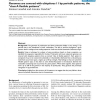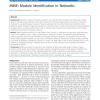51 search results - page 5 / 11 » Identifying Protein Flexibility by NMA |
BMCBI
2006
13 years 7 months ago
2006
Background: One of the most challenging aspects of protein-protein docking is the inclusion of flexibility into the docking procedure. We developed a postfilter where the grid-rep...
BMCBI
2005
13 years 7 months ago
2005
Background: The genomes of prokaryotes and lower eukaryotes display a very strong 11 bp periodic bias in the distribution of their nucleotides. This bias is present throughout a g...
JCB
2006
13 years 7 months ago
2006
Protein fold recognition is an important step towards understanding protein three-dimensional structures and their functions. A conditional graphical model, i.e., segmentation con...
BMCBI
2006
13 years 7 months ago
2006
Background: The structure of proteins may change as a result of the inherent flexibility of some protein regions. We develop and explore probabilistic machine learning methods for...
BMCBI
2011
12 years 10 months ago
2011
Background: Graphical models of network associations are useful for both visualizing and integrating multiple types of association data. Identifying modules, or groups of function...


